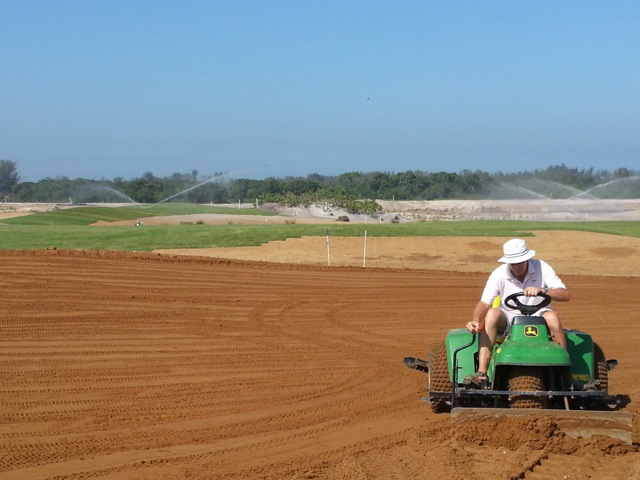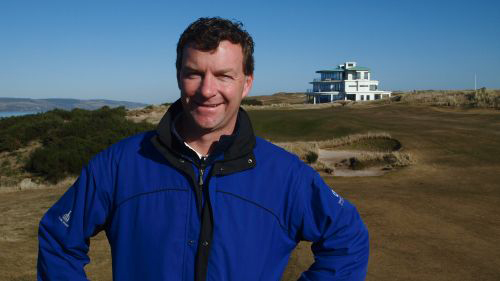Red will be on the greens (and fairways) at the Rio Olympics
By Tom Fleischman

When some of the world’s best golfers tee off in the 72-hole Olympic competition, they will be navigating fairways and greens imagined and designed by a pair of Cornellians.
One of them, in fact, was mentored early in his career by yet another Cornellian, who himself was among the finalists for the Olympic contract.
Gil Hanse, MLA ’89, bested a field of 29 of the world’s top golf architects four years ago and won the job of turning an abandoned sand mine in the Barra da Tijuca neighborhood of Rio de Janeiro into a golf course that could challenge the best players in the game, then be used as a municipal course for a city and nation just being introduced to the sport.
“It’s very humbling and an incredible honor,” Hanse told reporters shortly after winning the competition four years ago.
Hanse – an award-winning course architect who founded Hanse Golf Course Design in Malvern, Pennsylvania, in 1993 – enlisted the help of fellow Cornellian Frank Rossi, Ph.D. ’91, to come up with a grassing plan in keeping with his philosophy of tailoring the golf course to the site, and not the other way around.
“He’s the best – he’s so passionate,” Hanse said of Rossi, who is an associate professor in the College of Agriculture and Life Sciences’ School of Integrative Plant Science. “He was out there doing a lot of research for us. My partner, Jim Wagner, and I talked with him about what sort of characteristics we want the grass to have from a playability standpoint.”

“[Gil had a] real resistance to the homogenized kind of courses that the [PGA] Tour espouses. They all look the same, they all are managed the same way,” said Rossi.
Said Hanse: “It’s a sand-based site, and we told Frank we wanted something firm and fast and potentially bouncy. He did all the research and found Zeon zoysia, and it was a perfect match.”
Rossi chose the easy-to-maintain Zeon zoysia for most of the course, save for the greens, which feature Seashore paspalum, a grass that can stand up should the groundwater become brackish.
Hanse a long shot
Hanse was among a group of finalists that included such golf icons as Jack Nicklaus, Greg Norman, Gary Player and Robert Trent Jones Jr. – son of the Cornell golf course’s legendary namesake – vying to design and build the venue that would host the first Olympic golf competition since 1904. He understood he was a long shot.
“Within the golf cognoscente, we were well-known and respected,” he said of his small firm, which includes consultant Amy Alcott, an LPGA Hall of Famer. “Outside of that, there weren’t many people who knew who we were.”
Another of the final eight in Rio was renowned golf architect and author Tom Doak ’82, founder of Renaissance Golf Design, who hired and mentored Hanse in the early 1990s. The fact that Cornell played such a prominent role in both the bidding process and the actual design of the course was a source of pride for the 52-year-old Hanse.
“Absolutely,” he said, “especially with Tom Doak, Frank Rossi and myself all being affiliated with the university directly. It’s very exciting.”
After a frustrating series of stops and starts – the project started six months behind schedule, held up by a dispute involving a landowner – Hanse’s vision was finally realized in early 2015, nearly two years after construction began.
International Golf Federation President Peter Dawson, who was on the four-person panel that chose Hanse to design the course, has likened the 7,200-yard, par-71 men’s layout (6,500 yards, par-71 for the women) to the legendary Old Course at St. Andrews, Scotland, considered the birthplace of golf.
Environmental goals met
Earlier this year, Golf Digest bestowed upon the Olympic course its annual Green Star Award for outstanding environmental practices. The course lies within the 1,640-acre Marapendi Natural Reserve, a protected expanse along the coast.
That’s affirmation that Hanse was successful in following the stated goals of the Olympic golf organizers. The invitation to course designers included broad parameters: “a state-of-the-art championship golf course … a public facility catering to the emerging Rio golf market, with specific focus on youth play ... respecting the environmental and sustainable goals of Rio 2016 ... designed to minimize construction costs and to be efficient in its maintenance and golf operations.”
The Olympic Games run Aug. 5-21; the men’s golf competition is set for Aug. 11-14, the women’s Aug. 17-20. Hanse said he realizes his handiwork will be judged, in large part, on the how the competition unfolds, but added, “Hopefully the public perception is positive, and then we’re pretty confident that, long term, that we’ve created something that will have a lasting positive effect.”
Hanse, who will be in Rio for the games, hopes that all the pre-Olympics talk about the men’s players who won’t be there – due to fears of the Zika virus and other concerns – will be forgotten once the first tee shot is hit.
“I would hope that it will be compelling enough that that talk is over with,” he said, “and the conversation instead will focus on having great champions for the men and the women.”
Media Contact
Get Cornell news delivered right to your inbox.
Subscribe